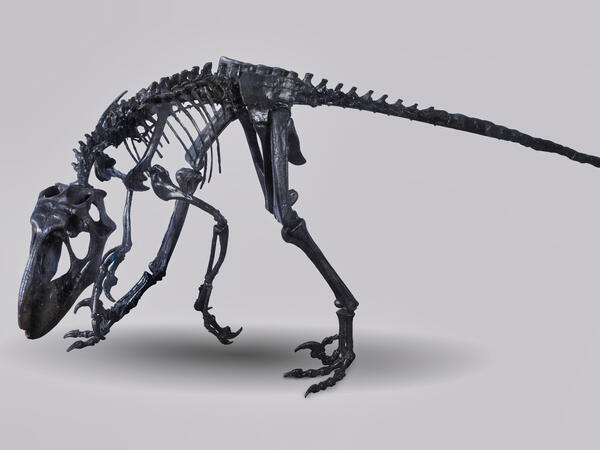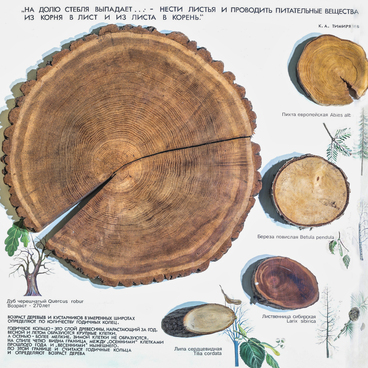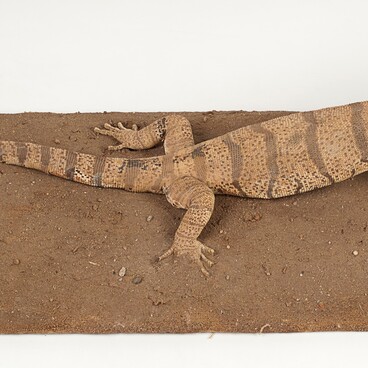The carnivorous dinosaur deinonychus, cast of which skeleton is exhibited in the State Biology Museum, inhabited the territory of modern North America more than 140 million years ago.
The first person who discovered deinonychus fossils was Barnum Brown, an American paleontologist. In summer of 1931, he was conducting an expedition near the town of Billings, Montana, where four years earlier he had discovered fragments of the herbivorous tenontosaurus fossils. During the excavation, Brown found fragments of skeleton encapsulated in limestone. They ‘were hard to prepare’, and the scientist took them away, but gave up attempts to describe them for a while.
The found skeleton is housed in the American Museum of Natural History. In the early 1960s, Brown showed it to John Ostrom, a student of Yale University. Four years later, Ostrom led the expedition during which the area was re-examined and several hundreds of bones were found near the town of Bridger. They were bones belonging to various species of dinosaurs.
Ostrom assembled a standard sample of two feet, compared it to the fossils discovered by Brown, and concluded that they belong to the same species. The paleontologist called the dinosaur which fossils he had found Deinonychus antirrhopus, which can be translated from Greek as ‘balancing terrible claw’.
Deinonychuses lived in the middle of the Cretaceous, the Mesozoic era, which is about 98-115 million years ago. The closest species to those predators were velociraptors, which inhabited Asia and which name means ‘swift seizer’ in Latin.
Deinonychuses were rather small, but very agile lizards which walked on two legs. Their weight was about 70 kilograms, they were one meter high and three meters long. Horizontal back and long heavy tail helped to maintain balance while running.
John Ostrom supposed that deinonychuses lived in packs. Such lifestyle helped them to attack rather big prey. The skeletons of younger individuals were marked with bites of other deinonychuses, which implies possibility of prey division hierarchy. For instance, Modern Komodo dragons do the same way. Larger individuals eat first, and smaller ones have to settle for scraps. If younger individuals trespass the older, older ones may eat them.
Despite the powerful jaw, deinonychuses' bite was not that strong. That is why their main weapon to attack prey was crescent claw. The dinosaurs lunged at prey, pressed it down with their body, and held it firmly with their claws. Prey was eaten while still being alive. However, those lizards won’t spare carrion.
Deinonychuses hunted herbivores; however, they were prey for bigger predators.
In the early 1970s, John Ostrom sent casts of many deinonychus skeleton fragments to The Paleontological Institute, Academy of Sciences of the Soviet Union. The staff of the institute restored the missing parts of the skeleton, they completely reconstructed the skull, partially the pelvis and some limb bones.
The first person who discovered deinonychus fossils was Barnum Brown, an American paleontologist. In summer of 1931, he was conducting an expedition near the town of Billings, Montana, where four years earlier he had discovered fragments of the herbivorous tenontosaurus fossils. During the excavation, Brown found fragments of skeleton encapsulated in limestone. They ‘were hard to prepare’, and the scientist took them away, but gave up attempts to describe them for a while.
The found skeleton is housed in the American Museum of Natural History. In the early 1960s, Brown showed it to John Ostrom, a student of Yale University. Four years later, Ostrom led the expedition during which the area was re-examined and several hundreds of bones were found near the town of Bridger. They were bones belonging to various species of dinosaurs.
Ostrom assembled a standard sample of two feet, compared it to the fossils discovered by Brown, and concluded that they belong to the same species. The paleontologist called the dinosaur which fossils he had found Deinonychus antirrhopus, which can be translated from Greek as ‘balancing terrible claw’.
Deinonychuses lived in the middle of the Cretaceous, the Mesozoic era, which is about 98-115 million years ago. The closest species to those predators were velociraptors, which inhabited Asia and which name means ‘swift seizer’ in Latin.
Deinonychuses were rather small, but very agile lizards which walked on two legs. Their weight was about 70 kilograms, they were one meter high and three meters long. Horizontal back and long heavy tail helped to maintain balance while running.
John Ostrom supposed that deinonychuses lived in packs. Such lifestyle helped them to attack rather big prey. The skeletons of younger individuals were marked with bites of other deinonychuses, which implies possibility of prey division hierarchy. For instance, Modern Komodo dragons do the same way. Larger individuals eat first, and smaller ones have to settle for scraps. If younger individuals trespass the older, older ones may eat them.
Despite the powerful jaw, deinonychuses' bite was not that strong. That is why their main weapon to attack prey was crescent claw. The dinosaurs lunged at prey, pressed it down with their body, and held it firmly with their claws. Prey was eaten while still being alive. However, those lizards won’t spare carrion.
Deinonychuses hunted herbivores; however, they were prey for bigger predators.
In the early 1970s, John Ostrom sent casts of many deinonychus skeleton fragments to The Paleontological Institute, Academy of Sciences of the Soviet Union. The staff of the institute restored the missing parts of the skeleton, they completely reconstructed the skull, partially the pelvis and some limb bones.



